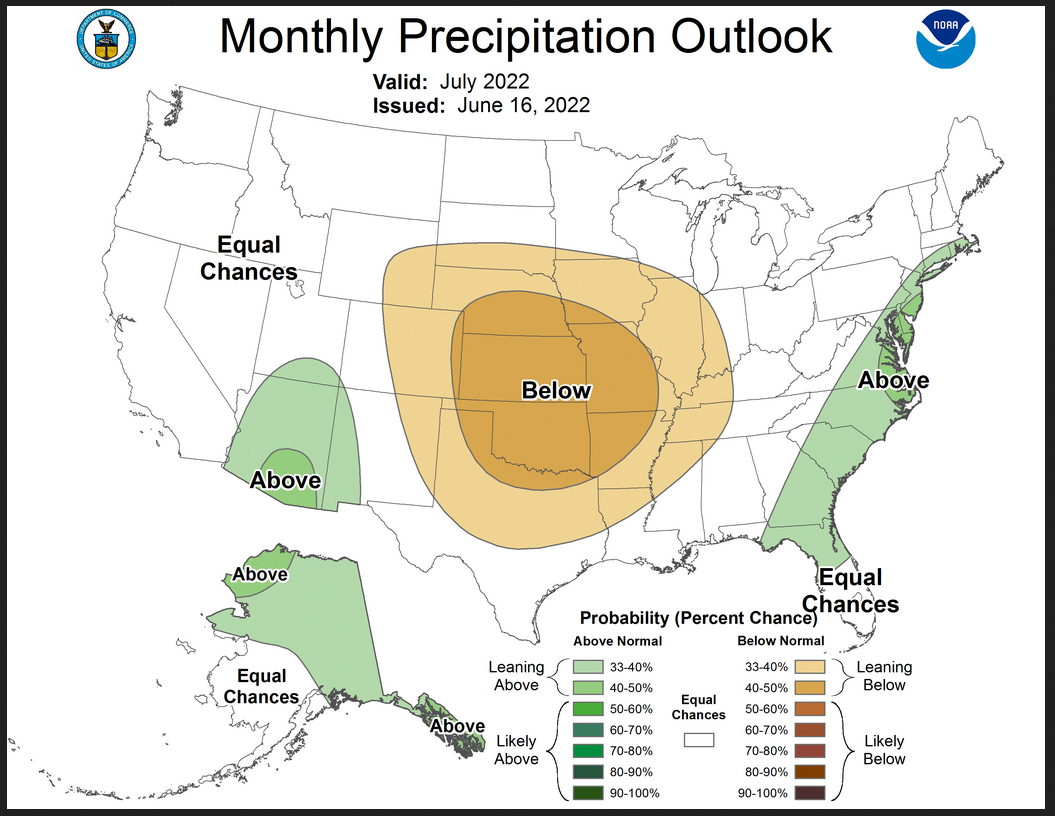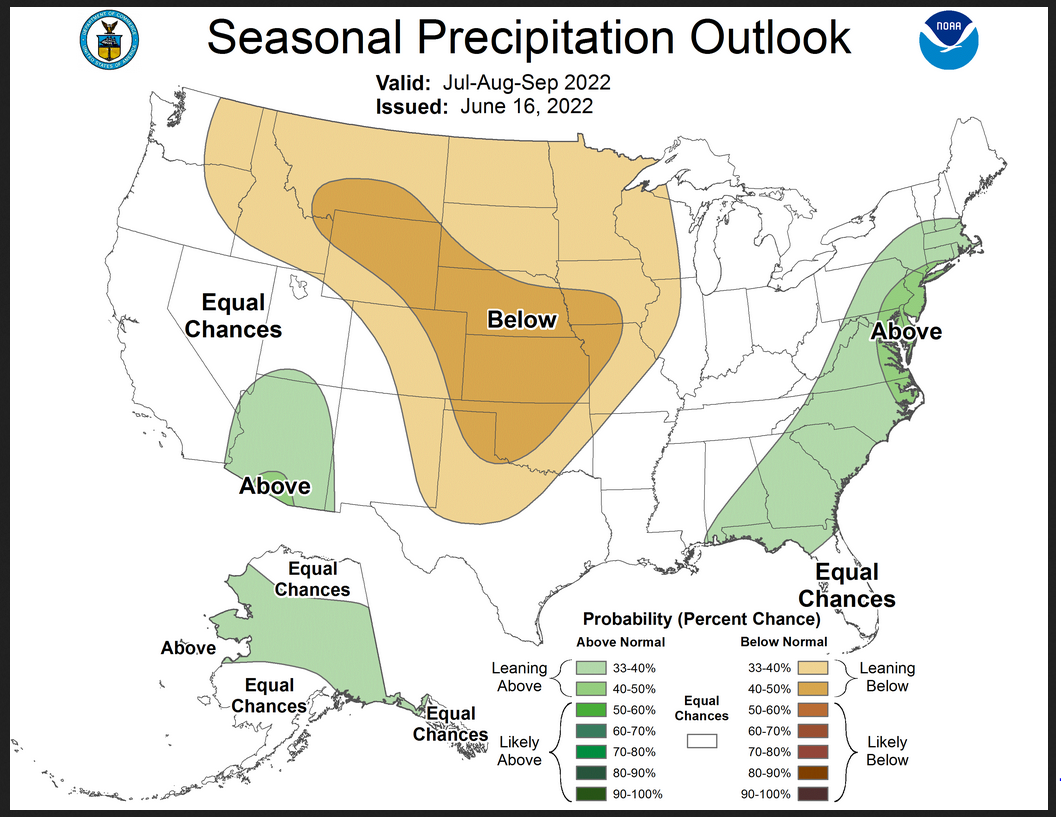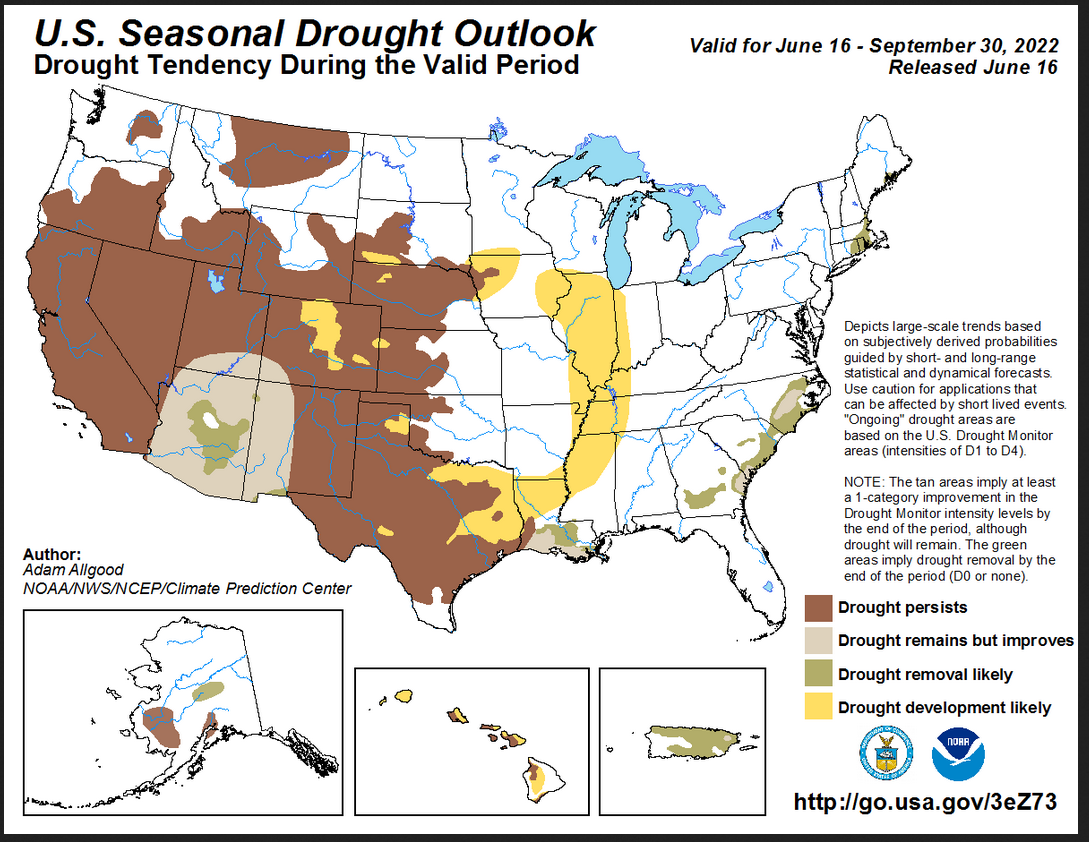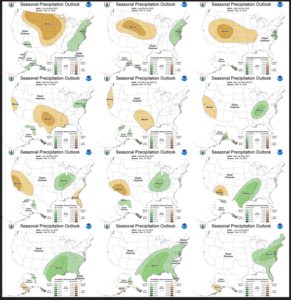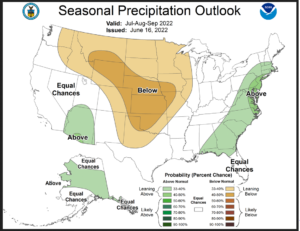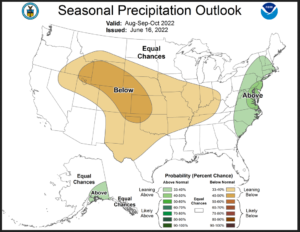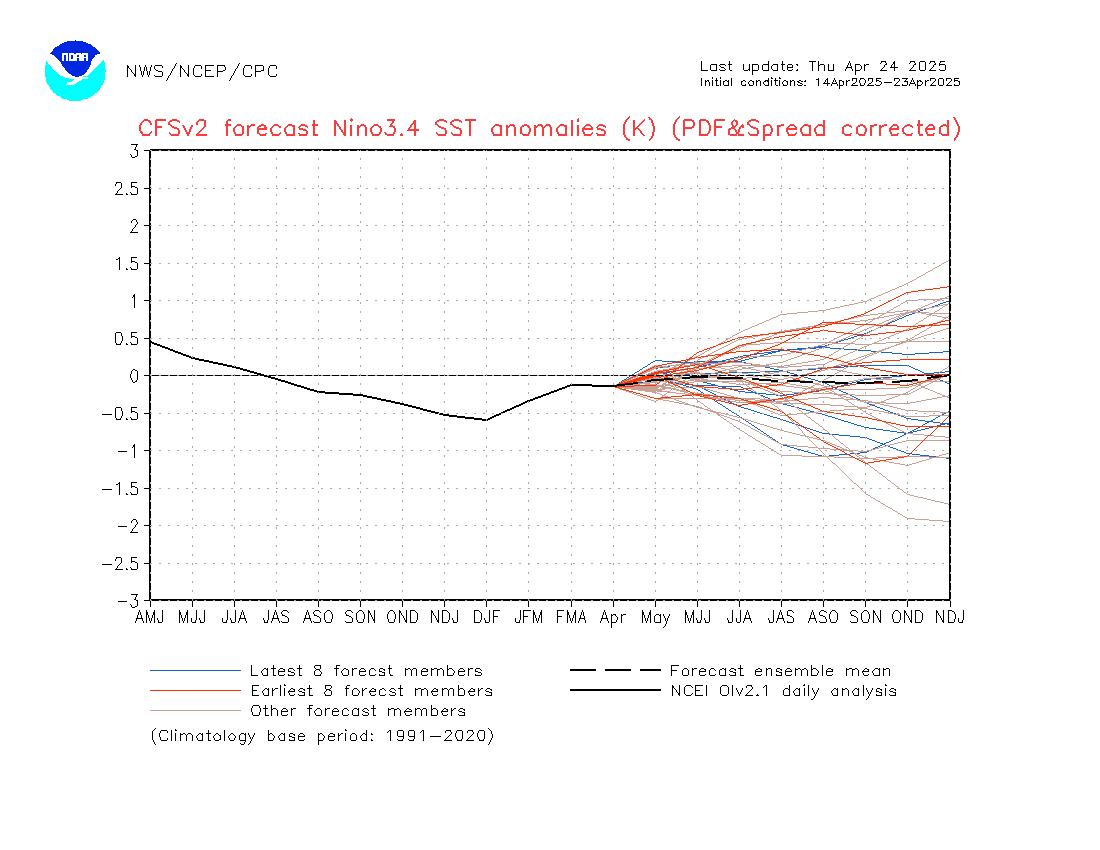.Updated at 5 pm EDT on June 18 to incorporate the Week 3 – 5 Outlook issued on June 17 which is somewhat different than the full-month outlook so it is of some interest.
Change Appears to be Coming – but a bit slower than it looked last month.
Today is the third Thursday of the month so right on schedule NOAA has issued what I describe as their Four-Season Outlook. The information released also includes the Early Outlook for the single month of July plus the drought outlook for the next three months. I summarize the information issued and provide links to additional maps.
Even though the IRI analysis issued last week seems to show the La Nina will end perhaps a bit sooner than previously forecast, the weather outlooks seem to show weather impacts lasting a month or two longer. Uncertainty in the ENSO forecast introduces greater than usual uncertainty in the Seasonal Outlook. But the decadal trends are strong so we see a lot of that in the longer-term outlooks.

Combination Early Outlook for July and the Three-Month Outlook
Notice that for temperature, the July and three-month outlooks are very similar. This suggests that the August/September outlook is also similar.
| For both temperature and precipitation, if you assume the colors in the maps are assigned correctly, it is a simple algebra equation to solve the month two/three anomaly probability for a given location = (3XThree-Month Probability – Month One Probability)/2*. So you can derive the month two/three outlook this way. You can do that calculation easily for where you live or for the entire map. |
Here are larger versions of the Temperature and Precipitation outlook maps for the single month of July.
The maps are pretty clear in terms of the outlook.
And here are large versions of the three-month JAS Outlook maps starting with temperature followed by precipitation.
The maps are larger versions of what was shown in the first graphic that had smaller versions of all four of these maps.
Drought Outlook
|
There is a bit of yellow essentially filling in some gaps. This Southwest drought is kind of like a bad dream that never ends but is getting some relief from the Monsoon. Hawaii does not look that great. Of concern is the development of drought in Eastern Texas and for the Mississippi River area which means the corn belt.
|
Looking out at Four Seasons.
Twelve Temperature Maps
Notice that this presentation starts with August/September/October (ASO) since JAS is considered the near-term and is covered earlier in the presentation. The changes over time are generally discussed in the discussion but you can see the changes easier in the maps.
|
|
|
| If you look closely you can see that DJF 2022/2023 the Southern Tier is shown warmer than it was shown last month. |
Twelve Precipitation Maps
Similar to Temperature in terms of the organization of the twelve overlapping three-month outlooks. The changes over time are generally discussed in the discussion but you can see the changes easier in the maps.
|
|
|
| If you look closely you can see that NDJ 2022/2023 and DJF 2022/2033 are drier along the Southern Tier than they were shown last month. But then things get wetter just as they were predicted last month. |
North American Monsoon (NAM)
The JAS Outlook is shown earlier. But that does not extend through the Monsoon. So I am showing one additional Outlook Map that extends farther in time.
I am showing them side by side.
|
|
|
| July through September covers the main part of the North American Monsoon (NAM) and you can see the forecasts is for a slightly better than average monsoon but the moisture is pretty much blocked from extending much beyond Arizona and New Mexico. Utah and Colorado may get some benefits as may southern texas. The next map shows that the blocking high dry area continues into October and whatever is left of the Monsoon is within the range of normal. Much of New Mexico is back into drought.
NOAA does not provide single-month Outlooks beyond the subsequent month so it is a little hard to interpret a three-month outlook. But if you spend some time looking at these maps you get an idea of what NOAA thinks will happen. That blocking dry area north and east of Arizona and New Mexico which is probably a high-pressure area limits the impact of the Monsoon on other states. |
NOAA Discussion
Maps tell a story but to really understand what is going you need to read the discussion. I combine the 30-day discussion with the long-term discussion and rearrange it a bit and add a few additional titles (where they are not all caps the titles are my additions). Readers may also wish to take a look at the article we published last week on the NOAA ENSO forecast. That can be accessed here.
I will use bold type to highlight some things that are especially important. My comments, if any, are enclosed in brackets [ ].
CURRENT ATMOSPHERIC AND OCEANIC CONDITIONS
Oceanic and atmospheric observations across the equatorial Pacific remain consistent with La Niña conditions. The observed weekly SSTs, centered on June 8, feature negative anomalies throughout the central and eastern equatorial Pacific with the largest negative anomalies of -0.5 to -1 degrees C generally from the Date Line to 120W. These negative anomalies have weakened since early May. Subsurface temperature anomalies (averaged between 180 to 100 degrees W and 0-300m depth) also weakened during the spring with values approaching zero. From May 13 to June 7, low-level easterly and upper-level westerly wind anomalies persisted. Suppressed convection continued over the western and central Pacific, while convection was near average or slightly enhanced across parts of Indonesia.
Multiple atmosphere Kelvin waves crossed the global tropics throughout this past spring. More recently during late May into the beginning of June, the Real-time Multivariate Madden Julian Oscillation (RMM) index depicted a slower moving and developing Madden Julian Oscillation (MJO) event. However, the propagation of this MJO stalled over the Western Hemisphere during early to mid-June and the amplitude of the RMM index decreased. As of June 15, GEFS and ECMWF ensemble spread is very large on the MJO evolution during the next two weeks. Therefore, forecast confidence is low on how much, if any, the MJO modulates tropical cyclone development across the East Pacific and Atlantic basins during the latter half of June and heading into July.
Positive SST anomalies, surrounding Alaska, have increased in magnitude since late May with the largest anomalies (more than +2.5 degrees C) observed along coastal southwestern Alaska. Following a prolonged period of anomalously cold SSTs along the West Coast, SSTs are now near average. Positive SST anomalies continued across the northern Gulf of Mexico and coastal waters from the Mid-Atlantic northward to New England.
PROGNOSTIC DISCUSSION OF SST FORECASTS
The CPC SST Consolidation for the Nino 3.4 region indicates a slight decrease in the magnitude of the negative anomalies this summer, followed by a decline to between -0.5 and -1 degrees C during the fall season. The spread among the statistical tools is large this fall, with outcomes ranging from slightly positive (CCA) to a moderate strength La Niña (constructed analog). The NMME maintains a La Niña with negative anomalies at or below -0.5 degrees C persisting through DJF 2022-2023. Since the observed oceanic and atmospheric anomalies have weakened recently, uncertainty is high on whether La Niña may transition to ENSO-neutral conditions this summer. As of early June, the CPC/IRI consensus forecast calls for a 52 percent chance of La Niña during July-August-September before slightly increasing to around 58 percent through the fall and early winter.
30-DAY OUTLOOK DISCUSSION FOR JULY 2022 [There is a lot of redundancy here]
La Niña conditions continue across the equatorial Pacific, with negative sea surface temperature (SST) anomalies over much of the east-central and eastern Pacific Ocean. However, negative SST anomalies weakened in magnitude and are generally between -0.5 and -1.0 degrees C over most of the equatorial east-central Pacific in recent weeks. Convection continues to be suppressed near the Date Line and additionally over the western Pacific. Low-level easterly winds are enhanced over parts of the east-central equatorial Pacific Ocean, while upper-level westerly winds are enhanced across most of the central and eastern equatorial Pacific Ocean. Negative subsurface temperature anomalies persist near the surface from the central equatorial Pacific Ocean to the eastern Pacific Ocean, while positive subsurface temperature anomalies persist at depths of about 100 to 200 m across the western and central equatorial Pacific Ocean.
Consolidated dynamical model forecasts
Consolidated dynamical model forecasts from the North America Multi-Model Ensemble (NMME) predict an initial weakening in the magnitude of negative SST anomalies in the Niño 3.4 region, bordering on ENSO-neutral conditions, slightly warmer than the -0.5 degree C threshold, with an increase in the magnitude of negative SST anomalies later in the boreal summer and into autumn. However, the CPC/IRI consensus ENSO outlook favors persistence of La Niña through summer with probabilities exceeding 50 percent, but indicates some uncertainty and the nearly as likely potential for ENSO-neutral conditions in the first seasonal lead, July-August-September (JAS). Although the impacts of a potentially ongoing La Niña influence the July temperature and precipitation outlooks for North America, the potential for ENSO-neutral conditions during the month of July limits the extent of use of ENSO-based forecast tools.
The Real-time Multivariate Madden Julian Oscillation
The Real-time Multivariate Madden Julian Oscillation (RMM) index indicates Madden Julian Oscillation (MJO) conditions have weakened. Forecasts of the MJO are highly uncertain at this time, and MJO does not play a role in the climate outlook for July. Dynamical model forecasts from the GEFS and ECMWF ensemble forecast systems for the beginning of July predict a ridge and positive 500-hPa height anomalies over the contiguous U.S. (CONUS), centered over the northwestern CONUS. Near-zero or negative mid-level height anomalies and a trough are predicted over the Gulf of Alaska and North Pacific to the west of the CONUS.
This predicted circulation pattern influences the temperature and precipitation forecasts for the beginning of July. The temperature and precipitation outlooks for July are based primarily on dynamical model forecasts from the NMME, the Copernicus International Multi-Model Ensemble (IMME or C3S), statistical tools, including the constructed analog of lagged temperature and precipitation based on current soil moisture conditions, and statistical forecasts of temperature and precipitation based on forecasts of the Niño 3.4 SST and on decadal trends . In addition, consolidations of statistical and dynamical tools for temperature and precipitation were consulted.
Temperature
The July temperature outlook slightly favors above normal temperatures across western Alaska, including Mainland Alaska and parts of the Aleutians, supported primarily by dynamical model forecasts from the NMME. Below normal temperatures are more likely for the southern Alaska Panhandle and the Washington and Oregon coasts, supported by dynamical model forecasts from the NMME, as well as the GEFS temperature forecast for early July. Above normal temperatures are favored over a large area of the CONUS, consistent with NMME forecasts and the consolidation of statistical and dynamical forecast tools.
Decadal trends as well as dry soil moisture conditions increase the probabilities for above normal temperature over much of the West, centered around the Central High Plains, and for parts of the Northeast. Probabilities for above normal temperatures are moderated over parts of the Southwest Monsoon region due to enhanced monsoon precipitation. Weaker signals and greater uncertainty among temperature tools lead to lower probabilities for above normal temperatures across the Central Mississippi and Ohio Valleys.
Precipitation
The July precipitation outlook favors above normal precipitation across most of Alaska including the Alaska Panhandle, and excluding southwestern Mainland Alaska and the Aleutians, consistent with the NMME mean anomalies, as well as the impacts of La Niña and decadal trends . With the location of positive 500-hPa height anomalies and a ridge predicted over the northwestern CONUS in the GEFS and ECMWF dynamical model forecasts for early July, as well as antecedent above normal temperatures and dry soil moisture conditions, an enhanced monsoon and above normal precipitation are favored for much of the Southwest, including most of Arizona, parts of southern Utah, and parts of western New Mexico.
Below normal precipitation is favored in the July monthly outlook for a large area of the central CONUS to the east of the Rockies, from the central High Plains to the Central Mississippi Valley and western areas of the Ohio Valley, consistent with dynamical model forecasts from the GEFS and ECMWF for the beginning of the month and the NMME and IMME forecasts for the full month. Dynamical model forecasts support slightly enhanced probabilities for above normal precipitation along the Atlantic Coast from northern Florida to southern New England, with greater probabilities due to decadal trends over parts of the Mid-Atlantic region.
SUMMARY OF THE OUTLOOK FOR NON-TECHNICAL USERS (Focus on July, August and September)
The July-August-September (JAS) 2022 temperature outlook favors above-normal seasonal mean temperatures across a majority of the U.S. The largest probabilities (more than 60 percent) of above-normal temperatures are forecast for New England and parts of the West. The JJA precipitation outlook depicts elevated probabilities of above-normal precipitation for parts of the East, Southwest, and Alaska, while below-normal precipitation is more likely across much of the Great Plains, western Corn Belt, upper Mississippi Valley, and the northern to central Rockies. Equal chances (EC) are forecast in areas where the likelihood of seasonal mean temperatures or seasonal accumulated precipitation amounts are expected to be similar to climatological probabilities.
A La Niña advisory remains in effect and equatorial sea surface temperatures (SSTs) are below average across the central and eastern Pacific Ocean, and the tropical Pacific atmosphere is consistent with a La Niña. La Niña is favored to continue through the Northern Hemisphere summer (52% chance in JAS 2022), with slightly increased probabilities throughout the Northern Hemisphere fall and early winter 2022 (58-59% chance).
BASIS AND SUMMARY OF THE CURRENT LONG-LEAD OUTLOOKS
PROGNOSTIC TOOLS USED FOR U.S. TEMPERATURE AND PRECIPITATION OUTLOOKS
Tools used for the seasonal outlooks included dynamical model guidance such as the North American Multi-Model Ensemble (NMME), the Calibration, Bridging, and Merging (CBaM) version of the NMME, and the Copernicus International Multi-Model Ensemble (C3S). Current soil moisture conditions played a role in the JAS temperature outlook, primarily across the Great Plains and Southwest. The consolidation tool, which includes NMME input and various statistical tools, was used more extensively beyond lead 5, NDJ. La Niña composites were considered through next winter since La Niña is the most likely outcome. Decadal trends in temperature and precipitation were a factor at all time leads but relied upon the most during the spring and summer 2023.
PROGNOSTIC DISCUSSION OF OUTLOOKS – JAS 2022 TO JAS 2023
TEMPERATURE
A broad coverage of above-normal temperatures is favored throughout much of the U.S. during JAS, but probabilities vary regionally. Along the East Coast, above-normal temperatures are most likely for New England due to: excellent agreement among tools including the inputs to the NMME, decadal temperature trends, and large positive SST anomalies nearby. Due to recent heavy rainfall, anomalously wet soil moisture is now present across southeast Kansas, northeast Oklahoma, and the Ozarks region. This was a contributing factor to a weakness in the probabilities for above normal temperatures for parts of the central CONUS along with the latest calibrated NMME and neutral decadal trends during mid to late summer. The NMME and C3S support large probabilities for above normal temperatures, centered across Utah and western Colorado, with probabilities decreasing to the south which is consistent with the JAS precipitation outlook slightly favoring an enhanced Monsoon.
EC is forecast for parts of the northern Great Plains, based on anomalously wet soil moisture and the NMME forecast. EC is also forecast for parts of the Pacific Northwest where the July outlook is slightly favoring below-normal temperatures and is supported by the calibrated NMME. Above-normal temperatures are slightly favored for Mainland Alaska, although forecast confidence is relatively low given weak signals among the tools and lack of skill recently.
Beginning in the fall 2022 and through winter 2022-2023, minor changes were made to the previous outlook, released on May 19. These modifications were based on the latest dynamical model solutions and La Niña composites. During the spring and summer 2023, the temperature outlook is generally consistent with decadal trends .
PRECIPITATION
For a majority of the CONUS and Alaska during JAS, either EC or limited probabilities (below 40 percent) for below or above-normal precipitation are forecast due to very weak signals in the calibrated NMME. Based on a consensus between the latest dynamical models and La Niña precipitation composites, below-normal precipitation is most likely for the north-central Rockies, much of the Great Plains, and the western Corn Belt. The week-2 dynamical models , which cover the last week of June, are consistent that low to mid-level moisture is likely to increase across the Southwest due to southeasterly flow. Week 3-4 dynamical models , valid for the first half of July, depict a favorable position of the 500-hPa ridge axis for enhanced monsoon rainfall.
Based on these factors for a robust start to the Monsoon, the July precipitation outlook, and the typical inverse relationship in Monsoon rainfall following a dry winter, above-normal precipitation is favored for the Desert Southwest. The favored area of wetness along parts of the East and Gulf Coasts is consistent with the outlook for a 65 percent chance of an above-normal Atlantic hurricane season. Also, decadal trends support the largest probabilities for above-normal precipitation across the Mid-Atlantic and parts of the Northeast. Many of the dynamical model tools support a small tilt for above-normal precipitation across the central interior of Mainland Alaska. Since probabilities for La Niña conditions are near 60 percent during the late fall and winter, a slightly favored area for below-normal precipitation was added to the southern tier of the CONUS. During the spring and summer 2023, the precipitation outlooks are based mostly on decadal trends .
ENSO Forecast
It is useful to review the ENSO forecasts used by NOAA to produce this Four-Season Outlook. We reported on that last week and you can read that article by clicking here https://econcurrents.com/2022/06/10/noaa-updates-the-enso-forecast-on-june-9-2022-maybe-yes-maybe-no-on-la-nina-ending-in-2022/
The key information used by NOAA follows.
May/June/July.

| It is important to realize that there is not much difference between ENSO Neutral with a La Nina Bias meaning the NINO 3.4 Index is close to -0.5C and a very weak La Nina where the NINO 3.4 Index is just slightly colder than -0.5C. The + and – thresholds are somewhat arbitrary. In Australia, they use + or – 0.8C as their threshold which appears to make more sense for that part of the World. Notice for JFM 2023 the probability of La Nina and ENSO Neutral is about equal. One way of looking at that is that the Nino 3.4 Index is likely to be close to -0.5C. |

New Information
With much gratitude, IRI did not complicate the situation this month.
But we will include one graphic namely the NOAA proprietary ENSO model. It is not the primary tool that NOAA uses but we find it to be useful.
The above will not auto-update. But the image will update if you click HERE. https://www.cpc.ncep.noaa.gov/products/people/wwang/cfsv2fcst/images3/nino34SeaadjPDFSPRDC.gif
This model no longer shows La Nina continuing indefinitely. It had been showing that for some time but NOAA relies more on the IRI Forecast. But perhaps this model is now showing that we may become ENSO Neutral for Late Fall or early Winter. This is my interpretation not the formal forecast of NOAA.
At any rate, we see we are going to experience mostly conditions consistent with a weak La Nina or ENSO Neutral with a La Nina bias. That means that it will not make a noticeable difference in our weather if the Nino 3.4 index is -0.4C, -0.5C or – 0.6C. The meteorologists in Australia disagree. They believe that the threshold they have established really divides La Nina weather from ENSO Neutral weather for them. There are many questions where additional research is justified.
Week 3-4 Analysis
I indicated that I would update the report tomorrow the new Week 3 – 4 Outlook was issued on Friday. I should have done it yesterday.
For all practical purposes what you are looking at now is the Outlook for the first half of July.


| Basically, this is the Outlook for the first half of July. The location of the Monsoon is a bit different than that issued by NOAA for the full month of July. But that difference may turn out to be the case. There are other major differences between the Outlook for the first half of July and the Early Outlook for the full month. Draw your own conclusions. |
Here is the NOAA (actually CPC) discussion
Week 3-4 Forecast Discussion Valid Sat Jul 02 2022-Fri Jul 15 2022
Across the tropical Pacific, the La Niña advisory remains in effect. However sea surface temperature (SST) anomalies have slightly weakened in the Niño regions. RMM indices indicate enhanced convection in the western Hemisphere. This may be reflective of a Rossby wave rather than a coherent Madden Julian Oscillation (MJO) signal. Dynamical model guidance predicts that the signal in the RMM indices will be short-lived before weakening by the end of the Week-2 period. However, other indicators, such as velocity potential, suggest the emergence of a more coherent MJO signal in both the ECMWF and GEFS. In the extratropics, the teleconnections including the Arctic and North Atlantic Oscillations are expected to be near-neutral. With these factors in mind, the current Week 3-4 Outlook relies on dynamical model guidance with additional considerations from soil moisture conditions.
Anomalous ridging
Anomalous ridging is consistently forecast by all dynamical model guidance (CFS, GEFS, ECMWF, and the SubX multi-model ensemble). The center of action is over the western CONUS. This large-scale ridging results in above normal temperatures for much of the eastern half of CONUS with strongest probabilities across the South. Equal chances (EC) of above or below temperatures are carved out for the Upper Midwest. This is based on where the ECMWF and soil moisture considerations suggest below normal temperatures. However, GEFS temperature solution is above normal for the region. The ECMWF also forecasts below normal temperatures in the Four Corners region. This is presumably related to enhanced monsoon activity that is strongest in Week-3. However, other model guidance favors weakly above normal temperatures for this region. Thus, EC is forecast for much of the Southwest.
Consistent with last week’s forecast, temperature probabilities continue to tilt toward below normal for the coastal Pacific Northwest. This is under weak troughing and slightly cool SST anomalies, but this cold signal recedes in Week-4. Across Alaska, probabilities of above normal temperatures are elevated along the southern coast. This is due to strong model agreement of the anomalous ridging over the Aleutians and warm SST anomalies.
The precipitation forecast reflects a continuation of the monsoon enhancement for parts of New Mexico and Arizona. Models agree well on wetter than normal conditions. But it should be noted that this signal weakens in Week-4, particularly in the GEFS solution.
Dynamical models also continue to align well on the reduced precipitation signal for the Upper Midwest. Across the North Slope of Alaska precipitation probabilities are enhanced from the onshore flow related to troughing over the Arctic Circle. EC are carved out for the remainder of CONUS and Alaska, where model signals are weak.
Near-normal SSTs dominate the region surrounding Hawaii. Dynamical model guidance from the SubX suite indicates equal chances of above or below normal temperature across the island. These models also favor a slight tilt toward below normal precipitation with strongest probabilities for dry conditions in the northwest.
Resources
The link for the drought outlook map and some discussions that come with the map can be found by clicking HERE.
| I hope you found this article interesting and useful |


